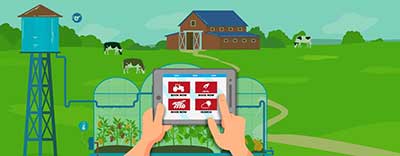Relevance: GS-3: Science and Technology- developments and their applications and effects in everyday life. Technology missions in Agriculture sector.
Key Phrases: Indian agritech, Farming as a Service (FaaS), Farm mechanization, high freight costs, scalability, Servitisation, Value-added services, and start-ups.
Why in News?
- The agritech ecosystem has attracted a surge of startups in India offering technology-based solutions like offtake marketplaces, storage and transportation services, and agronomy advisory services while large traditional players seek to reduce operational costs and manage scale more efficiently.
What is Agritech?
- It primarily refers to an ecosystem of companies and startup enterprises that are capitalizing on technological advancements to deliver products or services for increasing yield, efficiency – both in terms of time and cost, and profitability for farmers across the agriculture value chain.
The FaaS Ecosystem
- The ecosystem of farmers, equipment and service providers, technology and financing firms, and consumers can thrive from FaaS. Since the farmers only know their seasonally varying requirements better, they act as partners and coproduce the service with the agritech platforms and mobile apps.
- FaaS start-ups connect farmers and equipment owners to address the market opportunity for mutual benefits. They need to do well by doing good. FaaS utilises many business models, ranging from farm-to-warehouse, farm-to-mill, and farm-to-fork, linking farmers to the marketplace. Seeing a huge potential, even tech giants like IBM are betting big on the trend.
- The FaaS models bring all the parties, i.e., the farmers, the farm equipment manufacturers, the cooperative, and the government, onto a single platform. While some agritech players provide equipment-oriented services at affordable prices, e.g., land preparation, crop harvesting, and management, Agribolo’s innovative servitised models such as farm-to-fork link the farmers with marketplaces, including banks and financial institutions offering lower interest rates. Since the government has been promoting drones for crop insurance surveys, maintaining land records, and spraying pesticides, widespread adoption requires affordable prices for a win-win solution.
Overview of Agri-tech in India
- The overall agritech ecosystem witnessed a revenue growth of approximately 85 percent during FY 2019-20. An Ernst & Young 2020 study pegs the Indian agritech market potential at US$24 billion by 2025, of which only one percent has been captured so far.
- Meanwhile, another Bain & Company report, jointly produced with the Confederation of Indian Industry (CII) in March 2022, indicates that private equity investors have focused on systemic issues in the agritech industry and its sustainable development. Private equity investments in agritech start-ups between 2017 and 2020 amounted to INR 66 billion, growing at the rate of over 50 percent. Supporting this has been the growth of the rural microfinance sector – from INR 1.22 trillion in December 2019 to INR 1.46 trillion in March 2021. Agri credit grew from INR 8 trillion in FY 2014-15 to INR 14 trillion in FY 2019-20.
- The report notes that a surge of agritech start-ups have entered the ecosystem to offer technology-based solutions like off take marketplaces, storage and transportation services, and agronomy advisory services while large traditional players seek to reduce operational costs and manage scale via in-house solutions and new partnerships with emerging players. Global technology giants, like IBM and Microsoft, are looking at innovative solutions for crop health monitoring and yield estimates, for example.
- With ever increasing internet penetration in the country, and rural regions being the primary driver of this growth, India stands well equipped to adapt to changing methodologies in agriculture and transition from conventional business models to various innovative business models propelled by agritech.
How can the small landholders afford and access technology?
- The answer lies in embracing innovation. Sustainable food production requires transitioning from resource-intensive, high-input farming methods to long-term, outcome-based services. Thanks to agritech, even small farmers can adopt Farming as a Service (FaaS) as the panacea in emerging economies.
- It attracts a new interest from stakeholders — governments, non-government organizations (NGOs), the private sector, and the venture capitalists funding the start-ups. A toll-free number and a mobile app connects farmers to the platform to place their equipment and services orders. Shocks of equipment breakdown and consequent unexpected losses are avoidable as the farmers pay only for the equipment usage service.
- Digital agriculture aids farmers’ profitability. It uses digital devices, artificial intelligence (AI), and data analytics allowing farmers to make informed decisions to increase productivity and drive efficiencies. It uses high-tech tools to determine machine performance and satellite images to manage crop health and harvesting. That also involves farm machinery automation, robotics, connected weather stations, satellite data and sensors to monitor the crops, and logistics services to streamline supply chains. With the precision application of water and chemicals, digital agriculture acts as a game-changer.
How Agritech aids productivity and efficiency in India’s agriculture sector?
The various segments within the agritech sector, which support the overall value chain are:
- Market linkage – farm inputs: Digital marketplace and physical infrastructure to link farmers to inputs.
- Biotech: Research on plant and animal life sciences and genomics.
- Farming as a service: Farm equipment for rent on a pay-per-use basis.
- Precision agriculture and farm management: Use of geospatial or weather data, IoT, sensors, robotics etc. to improve productivity; farm management solutions for resource and field management, etc.
- Farm mechanization and automation: Industrial automation using machinery, tools and robots in seeding, material handling, harvesting, etc.
- Farm infrastructure: Farming technologies, such as greenhouse systems, indoor-outdoor farming, drip irrigation, and environmental control, such as heating and ventilation, etc.
- Quality management and traceability: Post-harvest produce handling, quality check and analysis, produce monitoring, and traceability in storage and transportation.
- Supply chain tech and output market linkage: Digital platform and physical infrastructure to handle post-harvest supply chain and connect farm output with the customers.
- Financial services: Credit facilities for input procurement, equipment, etc. as well as insurance or reinsurance of crop.
- Advisory/ Content: Information platforms online platform for agronomic, pricing, market information.
Way forward:
- FaaS attempts are still sporadic as the reach is limited to only a few states despite enormous potential and scope. Most startups face scalability issues. A few start-ups like Oxen Farm Solution and Gold Farm have already shut shop due to heavy funding requirements. Gold Farm’s platform could connect only around 250 booking agents and 500 tractor owners with farmers. Only the large business houses, e.g., M&M, operate countrywide.
- Availability of cold chains for perishable farm produce transportation by road or rail is a bottleneck in India. Airlifting involves substantially high freight costs. There is a massive potential for tech-enabled firms offering cold chain solutions creating an enormous opportunity in infra-sharing. FaaS start-ups need different models in upstream and downstream services for scalability. An extended shelf-life will ensure fresher produce, reduced losses, and lower logistics cost.
- FaaS promises to supercharge sustainable food production to solve global food scarcity problems. Empowering farmers and not just looking at them as a market is the need of the hour. Servitisation with digital technologies can establish farming as a respectable profession.
Source: The Hindu BL
Mains Question:
Q. FaaS promises to supercharge sustainable food production to solve global food scarcity problems. In this regard discuss the challenges faced by Agritech Start-up in India and suggest measures to tackle these challenges. Critically analyse.



















